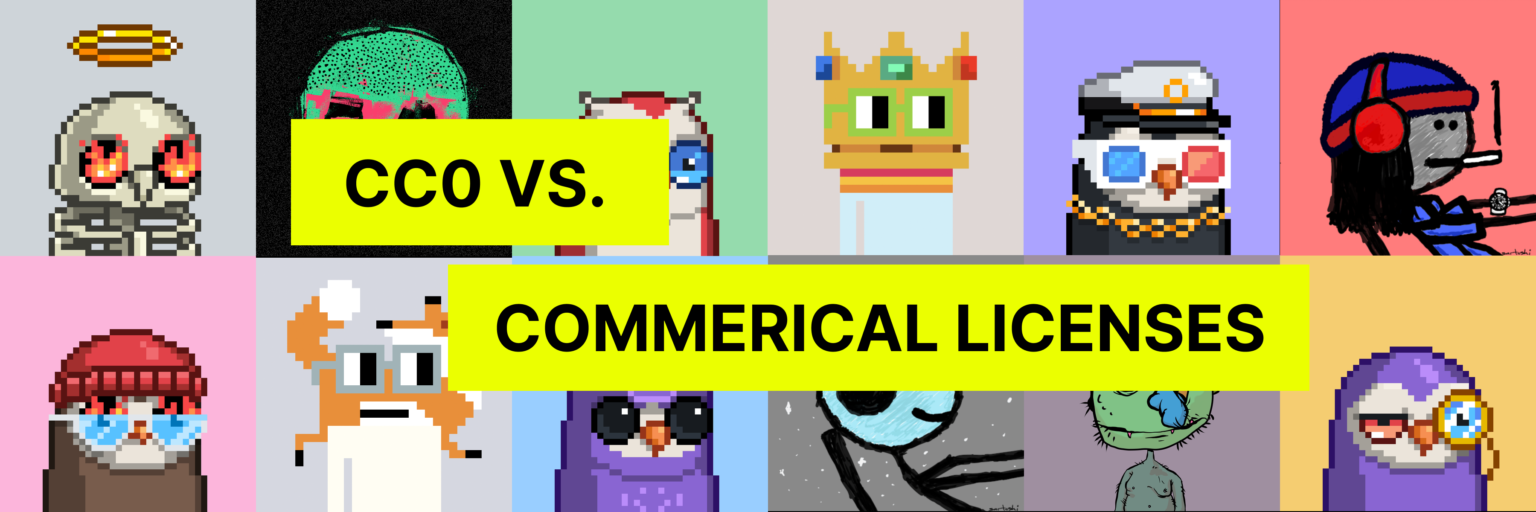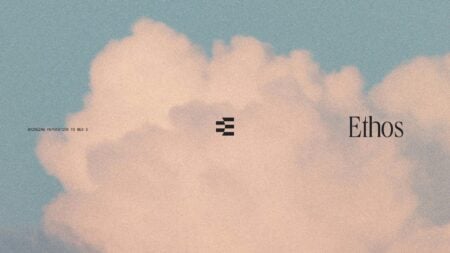IP Rights: CC0 VS. Commercial Licenses
Introduction
It’s rare that the week starts with a $195M hack and ends with that not being the biggest piece of news. The Nomad Bridge hack was completely overshadowed in the last few days by raging debates about the Moonbirds team’s decision to move the collection to a CC0 license.
While a lot of the conversation has been about the botched decision making process and communication strategy from the Moonbirds team, it has also paved the way for a larger conversation about when projects should use different types of IP rights. When the dust settles on this particular instance of commercial rights changes, we will find that we’re better equipped to articulate the pros and cons of each IP license. There is a time and place for each, and the right answer for what to use depends on community expectations. Let’s dig in…
CC0 sounds intimidating… What is it?
A “creative commons” license is CC0. If something is CC0 then it means others can freely build on, reuse, and remix the work without any further permission needed. Holders of CC0 licenses do not have the right to exclude others from using their IP.
Creators can opt into a CC0 license. This literally means they waive their rights to having exclusive usage over a piece of IP. It’s a big deal when a creator does this because once a CC0 license is granted it is irrevocable. In other words, once something is made CC0, the original creator cannot take it back. From that point forward anyone can reproduce the IP or remix it into something new.
In the case of NFTs, CC0 goes against the popular choice to grant commercial rights to the individual holder of each particular NFT. If an NFT collection gives commercial rights to its holders, then each unique holder has the exclusive right to use their own NFT in art, stories, media and more.
Some believe we are entering into “CC0 summer,” meaning there is a movement to embrace CC0 licenses and open up ownership over the art that’s created in the Web3 space. Others believe that having the commercial rights to your NFT is superior and will lead to more value in the long term. Below we explore the case for each option.
The bull case for CC0
There are two main reasons proponents of CC0 believe it is the way of the future:
- Its commitment to open development is a part of the “Web3 ethos”
- Ultimately granting a CC0 license to a collection will benefit the individual holders of NFTs because it will give the collection a better chance to become a more relevant part of culture. The thought is that this will accrue value back to each individual holder.
On a Moonbirds Twitter spaces on Friday afternoon, Kevin Rose spoke about how this decision fits the vision for Web3, saying “Under the hood, we see CC0 as a way to say we no longer rely on government institutions to tell us what we can and can’t do and it’s also a new type of decentralized brand. It’s using the blockchain as that single source of truth to point to the original owner.”
The rejection of centralized ownership has been a part of crypto culture from the beginning. You could liken the movement towards CC0 licensing to the shift towards open source code, protocols, or DAOs, where many believe that autonomous systems and decentralized ownership will lead to a more equitable future and ultimately pave the way for innovation.
“This is an opportunity. When I look at Web2 and all the mistakes we made, and I look at Web3, I see our opportunity to go back to first principles with the blockchain at the center of everything we do and say that’s our source of truth,”Kevin Rose said on Friday.
Proponents of CC0 also believe this licensing type will drive long term value to the collection because derivatives of the art will help it become a part of culture. Said more simply, there is a belief that people will be more likely to make memes out of the CC0 art or create sub-collections that callback to the original. In theory, this behavior could increase the value of the original because of the exposure they get through CC0.
By analogy, owning an original Picasso painting is valuable in part because the painting is recognizable. Others remix the Picasso, but the holder of the original still holds the original. This same is true with digital art. For example, XCOPY recently changed the licenses for his work to be CC0 for every work of art. These works are heavily used in memes and derivatives exist in other NFT collections, and the fame that has come from that led to an increase in value for all XCOPY works.
The Nouns Project has also benefited from decentralizing the brand. The already successful project reached a mainstream audience during the 2021 Super Bowl when Budweiser featured the Nouns glasses in their ad. This builds the brand which in turn leads to an increase in value for all holders.
The bull case for commercial rights
On the other hand, there are plenty of reasons why holders of NFTs would prefer to have the full commercial rights to that IP. PFPs have become a massive part of our digital identity. It makes sense that holders would like to own the rights to the visual representation of their digital identity. It is important for making sure the art isn’t misused and also because it allows the holder to directly accrue value based on their NFTs brand.
Many holders of NFTs with full commercial rights have created brands for their PFPs with the intention of licensing their avatars for partnership deals. But whether the IP can ultimately be licensed or not, we have seen that when holders do not own the commercial rights, it is less motivating for them to create a brand around their particular NFT. This is due to the fact that the holder loses the opportunity to monetize it, and it’s the opportunity itself that makes building so fun and exciting.
The holder of the rarest Moonbird, Lakoz (https://twitter.com/Lakoz_), spoke about losing a partnership deal for this Moonbird after the commercial rights were revoked. One of the reasons the partners backed out was because they could no longer guarantee creative control over how the art for that Moonbird would be used. If an NFT is CC0 then its art is a part of the public domain and is free for anyone to use, so someone is free to use it in a nefarious way which would hurt the brand that’s licensing the art. If the NFTs commercial rights are held by the holder, then they control how the NFT is depicted elsewhere.
Of course, a lot of the conversation in the last week has been about the loss of the opportunity to monetize. But commercial rights are about more than just the money. In the last year we’ve seen that commercial rights can be a catalyst for creation and community. Communities have created entire characters and stories for their NFTs. While we’re in the earliest innings of monetizing NFTs, we’ve seen that holders of NFTs with complete commercial rights have their imaginations opened up and that is arguably worth more than the chance to monetize.
J1mmy.eth says “The BAYC collectors leveraged the IP rights to make the project the success it is today… Giving IP rights to holders aligns incentives for both parties and can produce amazing results. BAYC is successful because of this… Some of us are leading the way and figuring out these exciting parts of NFT ownership with plans to help others do the same once the framework is in place. I’d rather spend time making my own NFTs valuable rather than your CC0 NFTs since there is a tangible and direct benefit.”
Jenkins The Valet (https://www.jenkinsthevalet.com/) is an obvious example of a project that has used licensing to drive creativity, but all throughout the Web3 ecosystem there are thousands of other examples of people creating characters as a way to express their creativity and have a creative outlet. Another great example is Reverie from WoW (https://www.thebookofreverie.com/book) who has an illustrated book about her character. Whether holders monetize or not, it is undeniable that commercial rights inspire creativity and development. You could argue that the holders could do the same thing with CC0 licenses, but the truth is that today Web3 community members have found more individual inspiration to create when they hold the commercial rights themselves.
The commercial rights licensing model fosters a sense of community because people feel a sense of ownership. In the Moonbirds spaces a community Member said, “Ownership leads to a different response. I don’t think Jenkins would exist without this model. And all those people in the project are so into it because they licensed into it. That’s the point.” In the case of BAYC or Jenkins The Valet we’ve seen how ownership has created a flywheel effect where the community is invested in the success of the brand because they have skin in the game. And don’t take it just from Jenkins – there are countless examples of characters, stories, and products that have spun out of different NFT communities because the holders were inspired to do something with their rights.
New ownership models are a part of vision for how blockchain technology can influence industries like Hollywood, content creation and marketing. Commercial rights enables holders to create a community around their character, and then leverage their ownership so they can see value accrue back to them for their work.
My take
There is a time and place for both CC0 and commercial licenses. One isn’t better than the other. It is more important to consider the desired utility of the NFT, why the project that created the NFTs exists in the first place, and what the community’s expectations are for how they want to use their NFTs. In a nutshell, if the utility of the NFT is for holders to express their individuality then a commercial license makes more sense. If the focus of the collection is more about the NFT brand a CC0 license may make more sense. In either case, great brands can be created. It’s important for project creators to deeply understand what their holders want to get out of it, because in the end it always comes back to the community, who are the people who actually control the future of the brand.
If the individual pieces of a collection are more fungible and the point of owning is more about being able to buy into the collective brand, then projects should use a CC0 license. A CC0 license benefits a project if the NFT is meant to be a cultural artifact like the works from XCOPY. In this case, the value of the collection goes up when the work is a part of meme culture. CC0 is also the right license for a project like Nouns where people are buying a piece of a brand and voting rights into a DAO.
On the other hand, when individuality is important (like in most PFP/digital identity projects) commercial licenses are likely the better move. Bored Ape Yacht Club has built a prolific brand because of the creativity of their community. That creativity was sparked by a sense of ownership from holders. But you don’t need to be BAYC (https://twitter.com/BoredApeYC) to take advantage of creative holders who have their own commercial rights. Even just recently the Tankies project (recently revived by Otto the Poolboy) licensed characters from their own community to put them on skateboards. This move will bring modest revenue to Tankies holders, but more importantly, it inspires them to build more identity around their individual Tankie holdings.
We’re still early in this debate, and only time will tell how it plays out. As Kevin Rose said at the start of the Moonbirds twitter spaces, “I’m ready for the tough questions. This is going to be fun.”
Disclosure: I am the Head of Product & Design at Tally Labs (https://twitter.com/TallyLabsNFT). As such, I am affiliated with Jenkins the Valet. All opinions are my own.
if you want to read more on this topic click here




